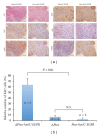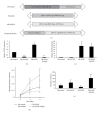Conditional Inactivation of Pten with EGFR Overexpression in Schwann Cells Models Sporadic MPNST
- PMID: 23319880
- PMCID: PMC3539440
- DOI: 10.1155/2012/620834
Conditional Inactivation of Pten with EGFR Overexpression in Schwann Cells Models Sporadic MPNST
Abstract
The genetic mechanisms involved in the transformation from a benign neurofibroma to a malignant sarcoma in patients with neurofibromatosis-type-1- (NF1-)associated or sporadic malignant peripheral nerve sheath tumors (MPNSTs) remain unclear. It is hypothesized that many genetic changes are involved in transformation. Recently, it has been shown that both phosphatase and tensin homolog (PTEN) and epidermal growth factor receptor (EGFR) play important roles in the initiation of peripheral nerve sheath tumors (PNSTs). In human MPNSTs, PTEN expression is often reduced, while EGFR expression is often induced. We tested if these two genes cooperate in the evolution of PNSTs. Transgenic mice were generated carrying conditional floxed alleles of Pten, and EGFR was expressed under the control of the 2',3'-cyclic nucleotide 3'phosphodiesterase (Cnp) promoter and a desert hedgehog (Dhh) regulatory element driving Cre recombinase transgenic mice (Dhh-Cre). Complete loss of Pten and EGFR overexpression in Schwann cells led to the development of high-grade PNSTs. In vitro experiments using immortalized human Schwann cells demonstrated that loss of PTEN and overexpression of EGFR cooperate to increase cellular proliferation and anchorage-independent colony formation. This mouse model can rapidly recapitulate PNST onset and progression to high-grade PNSTs, as seen in sporadic MPNST patients.
Figures





Similar articles
-
PTEN and NF1 inactivation in Schwann cells produces a severe phenotype in the peripheral nervous system that promotes the development and malignant progression of peripheral nerve sheath tumors.Cancer Res. 2012 Jul 1;72(13):3405-13. doi: 10.1158/0008-5472.CAN-11-4092. Epub 2012 Jun 14. Cancer Res. 2012. PMID: 22700876 Free PMC article.
-
Trp53 haploinsufficiency modifies EGFR-driven peripheral nerve sheath tumorigenesis.Am J Pathol. 2014 Jul;184(7):2082-98. doi: 10.1016/j.ajpath.2014.04.006. Epub 2014 May 13. Am J Pathol. 2014. PMID: 24832557 Free PMC article.
-
Spatially- and temporally-controlled postnatal p53 knockdown cooperates with embryonic Schwann cell precursor Nf1 gene loss to promote malignant peripheral nerve sheath tumor formation.Oncotarget. 2016 Feb 16;7(7):7403-14. doi: 10.18632/oncotarget.7232. Oncotarget. 2016. PMID: 26859681 Free PMC article.
-
New Frontiers in Therapy of Peripheral Nerve Sheath Tumors in Patients With Neurofibromatosis Type 1: Latest Evidence and Clinical Implications.Anticancer Res. 2020 Apr;40(4):1817-1831. doi: 10.21873/anticanres.14136. Anticancer Res. 2020. PMID: 32234870 Review.
-
The Challenge of Cancer Genomics in Rare Nervous System Neoplasms: Malignant Peripheral Nerve Sheath Tumors as a Paradigm for Cross-Species Comparative Oncogenomics.Am J Pathol. 2016 Mar;186(3):464-77. doi: 10.1016/j.ajpath.2015.10.023. Epub 2015 Dec 28. Am J Pathol. 2016. PMID: 26740486 Free PMC article. Review.
Cited by
-
Single-cell sequencing analysis reveals development and differentiation trajectory of Schwann cells manipulated by M. leprae.PLoS Negl Trop Dis. 2023 Jul 21;17(7):e0011477. doi: 10.1371/journal.pntd.0011477. eCollection 2023 Jul. PLoS Negl Trop Dis. 2023. PMID: 37478057 Free PMC article.
-
Malignant Peripheral Nerve Sheath Tumors State of the Science: Leveraging Clinical and Biological Insights into Effective Therapies.Sarcoma. 2017;2017:7429697. doi: 10.1155/2017/7429697. Epub 2017 May 16. Sarcoma. 2017. PMID: 28592921 Free PMC article. Review.
-
Comprehensive establishment and characterization of orthoxenograft mouse models of malignant peripheral nerve sheath tumors for personalized medicine.EMBO Mol Med. 2015 May;7(5):608-27. doi: 10.15252/emmm.201404430. EMBO Mol Med. 2015. PMID: 25810463 Free PMC article.
-
Co-targeting the MAPK and PI3K/AKT/mTOR pathways in two genetically engineered mouse models of schwann cell tumors reduces tumor grade and multiplicity.Oncotarget. 2014 Mar 30;5(6):1502-14. doi: 10.18632/oncotarget.1609. Oncotarget. 2014. PMID: 24681606 Free PMC article.
-
Overexpression of PDGFRA cooperates with loss of NF1 and p53 to accelerate the molecular pathogenesis of malignant peripheral nerve sheath tumors.Oncogene. 2017 Feb 23;36(8):1058-1068. doi: 10.1038/onc.2016.269. Epub 2016 Aug 1. Oncogene. 2017. PMID: 27477693 Free PMC article.
References
-
- Friedman JM. Epidemiology of neurofibromatosis type 1. American Journal of Medical Genetics. 1999;89(1):1–6. - PubMed
-
- Rosenfeld A, Listernick R, Charrow J, Goldman S. Neurofibromatosis type 1 and high-grade tumors of the central nervous system. Child’s Nervous System. 2010;26(5):663–667. - PubMed
-
- Beert E, Brems H, Daniels B, et al. Atypical neurofibromas in neurofibromatosis type 1 are premalignant tumors. Genes Chromosomes Cancer. 2011;50(12):1021–1032. - PubMed
Grants and funding
LinkOut - more resources
Full Text Sources
Other Literature Sources
Molecular Biology Databases
Research Materials
Miscellaneous

